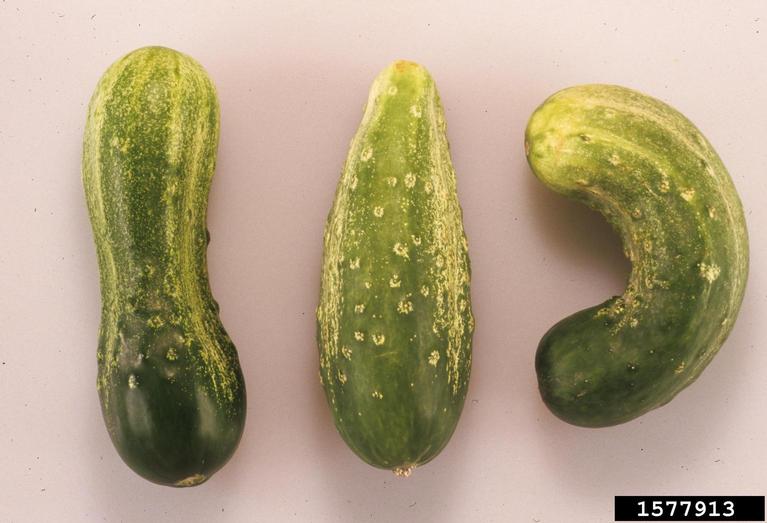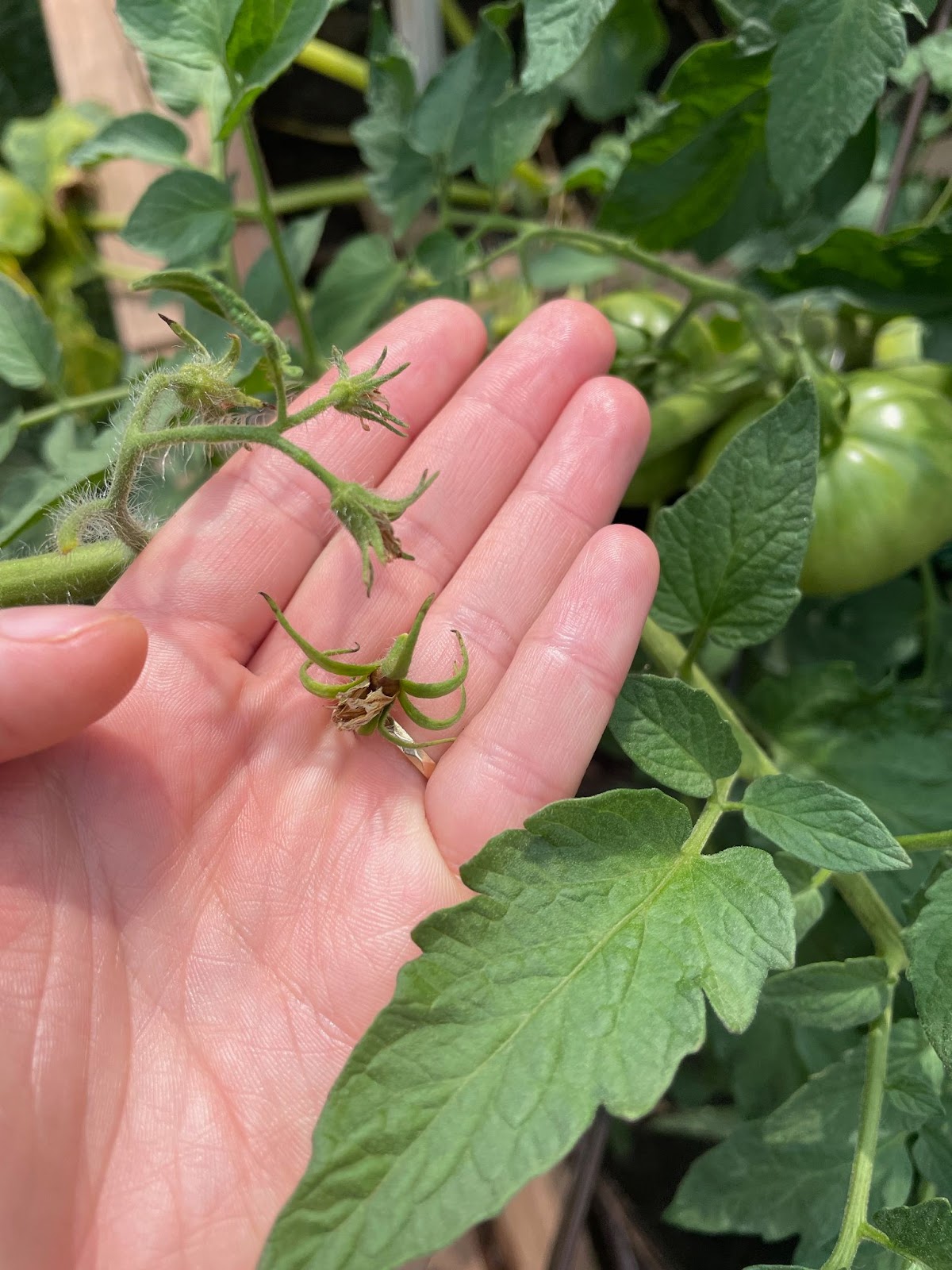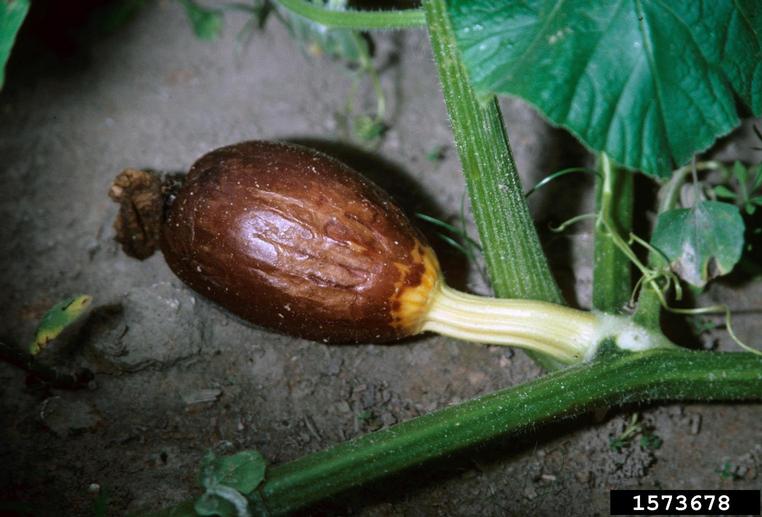Author: Marissa Schuh, Integrated Pest Management Extension Educator, University of Minnesota Extension. Reviewed by Natalie Hoidal. Originally publishes July 2021, updated July 2024.
We are hitting the growing season's first heat wave. While the last few years have been hot, you can refresh yourself on the ways hot weather can change the way our crops grow and yield.
Potential Issue 2: Hot temperatures change what type of flowers some vegetables produce

Vining vegetables in the cucurbit family (pumpkins, squash, melons, cucumbers, and the like) produce male and female flowers. Look at the base of the flower to tell the sex.
Potential Issue 3: Many bees don’t like it hot

In crops that depend on pollinators, such as members of the vine crop family, hot weather can impact bee activity, causing reduced fruit set. Just as we like to take it easy and rest in the shade on a hot day, so do many bees.
The ideal range for pollination for many species of bees is somewhere between 60° and 90° F, with hotter temperatures in this range promoting more pollination. Once it gets over 90° F, many bees slow down and pollinate less. This can be especially pronounced in crops like cucumbers, whose small flowers aren’t particularly attractive to many bees.
Pollination may occur, but not at a high enough level. This can lead to deformed cucumbers, summer squash and melons.
Hot weather can impact fruit that is still growing
Potential Issue 2: Hot nights mean fruit doesn’t ripen

Tomato plants across the state are loaded with green fruit. Maybe grape tomato varieties are being harvested, but many slicing and beefsteak tomatoes seem to be holding onto green fruit that just won’t turn red.
The optimum temperature range for tomato maturation is between 68° F and 77° F, while the pigments that turn ripe tomatoes red aren’t produced above 85° F. Once we start to get some cooler nights, tomatoes will again have some hours in their ideal ripening temperature range, allowing for tomatoes to fully ripen and redden.
So, now what?
Unfortunately, there really isn’t much to be done but wait out the hot temperatures. Cool nights will solve many of these issues, though the Climate Prediction Center is predicting the season will continue to be warmer than normal.
Make notes on how your vegetable varieties are performing, and consider trying a new heat-tolerant variety in the future.
Sources
Drost, D. (2020, April). Beans in the Garden. https://digitalcommons.usu.edu/cgi/viewcontent.cgi?article=1243&context=extension_curall.
Johnson, G. (2015, July 24). Heat Effects on Vegetable and Fruit Crops. Weekly Crop Update. https://sites.udel.edu/weeklycropupdate/?p=8354.
Lerner, R. (n.d.). Tomatoes Not Ripening? https://www.purdue.edu/hla/sites/yardandgarden/tomatoes-not-ripening/.
Nair, A. (n.d.). Where are the Female Flowers? Where are the Female Flowers? | Horticulture and Home Pest News. https://hortnews.extension.iastate.edu/2016/07-29/cucurbits.htm.
Ozores-Hampton, M., Kiran, F., & McAvoy, G. (n.d.). Blossom Drop and Reduced Fruit Set in Tomato. https://swfrec.ifas.ufl.edu/docs/pdf/veg-hort/tomato-institute/presentations/ti2011/ozores.pdf.
Runkle, E. (2018, March). Causes of Flower Bud Abortion. Greenhouse Product News, 42. https://gpnmag.com/article/causes-of-flower-bud-abortion/
We are hitting the growing season's first heat wave. While the last few years have been hot, you can refresh yourself on the ways hot weather can change the way our crops grow and yield.
Ways hot weather impact crops before fruit set
Potential issue 1: Hot day and nighttime temperatures cause flowers to drop

If you are still seeing flowers, but aren’t getting the tomatoes, peppers, beans or zucchini you are expecting, there can be a few heat-related factors in play.
The first is flower abortion: flowers form, but then die and fall off the plant before becoming fruit. Flower abortion can happen at temperatures ranging from 75° F to 95° F.
Dropped flowers have been noticeable in tomatoes this year. Tomatoes produce new flowers often, and the flowers have a 50-hour-long window in which to be pollinated. When tomatoes are exposed to sustained hot temperatures (more than 85° F in the day and 70° F at night), the tomato plant becomes stressed and burns through its energy stores. This changes the flowers, making it harder for them to be pollinated, and the blossom often drops out without pollination occurring. So during 50-hour periods that have hot days and especially hot nights, a round of tomato flowers are likely to drop off without pollinating.
You may start to notice something similar happening with green beans, which can also abort flowers in hot temperatures (over 95° F), especially if the soil is dry.
Aborted flowers wither and become brittle, falling off the plant easily. Photo: Marissa Schuh, University of Minnesota Extension
The first is flower abortion: flowers form, but then die and fall off the plant before becoming fruit. Flower abortion can happen at temperatures ranging from 75° F to 95° F.
Dropped flowers have been noticeable in tomatoes this year. Tomatoes produce new flowers often, and the flowers have a 50-hour-long window in which to be pollinated. When tomatoes are exposed to sustained hot temperatures (more than 85° F in the day and 70° F at night), the tomato plant becomes stressed and burns through its energy stores. This changes the flowers, making it harder for them to be pollinated, and the blossom often drops out without pollination occurring. So during 50-hour periods that have hot days and especially hot nights, a round of tomato flowers are likely to drop off without pollinating.
You may start to notice something similar happening with green beans, which can also abort flowers in hot temperatures (over 95° F), especially if the soil is dry.
Potential Issue 2: Hot temperatures change what type of flowers some vegetables produce
Maroon arrow points to a female zucchini flower, while the yellow arrow points to a male flower. Photo: Howard F. Schwartz, Colorado State University, Bugwood.org
Vining vegetables in the cucurbit family (pumpkins, squash, melons, cucumbers, and the like) produce male and female flowers. Look at the base of the flower to tell the sex.
- Female cucurbit flowers will be swollen underneath in the area that will eventually become the pumpkin, zucchini, etc.
- Male flowers will have just a straight stem.
Potential Issue 3: Many bees don’t like it hot
Cucumber fruit develop odd and uneven shapes when not fully pollinated. Photo: Gerald Holmes, Strawberry Center, Cal Poly San Luis Obispo, Bugwood.org
The ideal range for pollination for many species of bees is somewhere between 60° and 90° F, with hotter temperatures in this range promoting more pollination. Once it gets over 90° F, many bees slow down and pollinate less. This can be especially pronounced in crops like cucumbers, whose small flowers aren’t particularly attractive to many bees.
Pollination may occur, but not at a high enough level. This can lead to deformed cucumbers, summer squash and melons.
Hot weather can impact fruit that is still growing
Potential Issue 1: Poor pollination results in fruit that can’t grow

Some growers of vine crops have noticed small squashes, pumpkins and melons forming but then rotting. You may think that this is caused by disease, as the small fruit are often breaking down, soft, and covered in mold.
A more common cause is poor pollination. Just as poor pollination can result in misshapen fruits, it can also result in fruit that form and then quickly die.
Green beans can have similar issues. During periods of hot weather bean flowers produce less pollen, which cascades into fewer, smaller pods containing fewer, smaller beans.
This pumpkin was poorly pollinated, resulting in it dying and rotting. Photo: Gerald Holmes, Strawberry Center, Cal Poly San Luis Obispo, Bugwood.org.
Some growers of vine crops have noticed small squashes, pumpkins and melons forming but then rotting. You may think that this is caused by disease, as the small fruit are often breaking down, soft, and covered in mold.
A more common cause is poor pollination. Just as poor pollination can result in misshapen fruits, it can also result in fruit that form and then quickly die.
Green beans can have similar issues. During periods of hot weather bean flowers produce less pollen, which cascades into fewer, smaller pods containing fewer, smaller beans.
Potential Issue 2: Hot nights mean fruit doesn’t ripen
Ripe green tomatoes will have fully formed seeds surrounded by a clear jelly. These green tomatoes are almost ripe. Photo: Vegan Feast Catering, CC BY 2.0 <https://creativecommons.org/licenses/by/2.0>, via Wikimedia Commons
Tomato plants across the state are loaded with green fruit. Maybe grape tomato varieties are being harvested, but many slicing and beefsteak tomatoes seem to be holding onto green fruit that just won’t turn red.
The optimum temperature range for tomato maturation is between 68° F and 77° F, while the pigments that turn ripe tomatoes red aren’t produced above 85° F. Once we start to get some cooler nights, tomatoes will again have some hours in their ideal ripening temperature range, allowing for tomatoes to fully ripen and redden.
So, now what?
Unfortunately, there really isn’t much to be done but wait out the hot temperatures. Cool nights will solve many of these issues, though the Climate Prediction Center is predicting the season will continue to be warmer than normal.
Make notes on how your vegetable varieties are performing, and consider trying a new heat-tolerant variety in the future.
Sources
Drost, D. (2020, April). Beans in the Garden. https://digitalcommons.usu.edu/cgi/viewcontent.cgi?article=1243&context=extension_curall.
Johnson, G. (2015, July 24). Heat Effects on Vegetable and Fruit Crops. Weekly Crop Update. https://sites.udel.edu/weeklycropupdate/?p=8354.
Lerner, R. (n.d.). Tomatoes Not Ripening? https://www.purdue.edu/hla/sites/yardandgarden/tomatoes-not-ripening/.
Nair, A. (n.d.). Where are the Female Flowers? Where are the Female Flowers? | Horticulture and Home Pest News. https://hortnews.extension.iastate.edu/2016/07-29/cucurbits.htm.
Ozores-Hampton, M., Kiran, F., & McAvoy, G. (n.d.). Blossom Drop and Reduced Fruit Set in Tomato. https://swfrec.ifas.ufl.edu/docs/pdf/veg-hort/tomato-institute/presentations/ti2011/ozores.pdf.
Runkle, E. (2018, March). Causes of Flower Bud Abortion. Greenhouse Product News, 42. https://gpnmag.com/article/causes-of-flower-bud-abortion/
Comments
Post a Comment